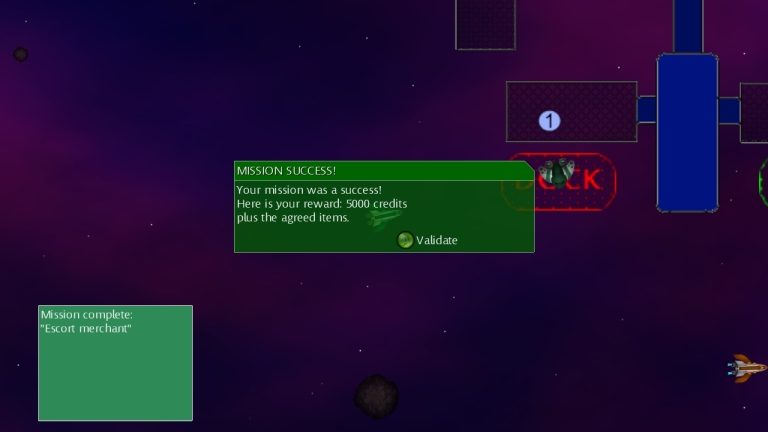
Game thumbnail
As the game isn’t yet available, I thought I’d make a virtual tour of NSN, to build interest and gain feedback.
Simply put, Next Stop: Nowhere! is a 2D space roaming shooter with depth. It is a space shooter, no denying it: you’re in control of a spaceship and you blast other ships (and props). But it has a lot more to offer.
Firstly, it’s not a side or vertical scroller. You get to go wherever you want in a top-down viewed universe (well, I know ‘top-down’ doesn’t make ANY sense in a ‘universe’, but it’s a game, mmm? 🙂 And the universe is flat, everyone knows that anyway! ;-)). I very much wanted to give a sensation of space, of freedom and use it to create interesting events and settings (ambushes, patrols, etc).
One important key feature also is that the universe is procedurally generated. What does this mean for the player? Discovery and replayability. Creating it programatically as opposed to fully level designed allows me to have a much bigger universe, a little more chaotic than I would have made it by hand. I will explain the system in details in another blog entry.
Now the depth. This is not a mindless shooter, like, not at all. It’s much more a sandbox-style game. If you go an a rampage against law-abiding space citizens, you’ll have to avoid military controlled space. On the other hand, if you hunt pirates, you’d be more popular with the police, but shot on sight by outlaws. Then there is trade. You can upgrade your ship, buy a better one and so on, but not only. You can also buy and sell various items, raw minerals and precious gems, that you might obtain in several ways: buying from a merchant on a station, mining from asteroids (obviously you will get only raw stuff from asteroids), looting from destroyed ships or sometimes when completing missions. Which leads me to…
Missions. Yes there are missions. There are ALWAYS missions. Wherever you go, each time you find a space station, there will be something to do. Whether it’s a dull, uneventful patrol around the station or a raid against neighbors or playing babysitter for frightened roaming merchants wanting to cross pirate-controlled space or a request that you go explore an uncharted area of the galaxy will depend on the moment and the location and type of the station. And there is another kind of missions, those advancing the story line. You will be lead to discover the galaxy, and its numerous denizens and their plots, if you choose to play these. Some will change the face of the universe, no kidding.
A-life (short for Artificial Life) is the last feature I’ll talk about now. That was always a favorite of mine and it features prominently in this game. I’ve already mentioned the missions, they’re a part of the A-life system. Many things are constantly generated to populate the universe in the most convincing way possible. Apart from missions, there are rumors which you can pick up in stations, patrollers, pirates, merchants and miners that you can see flying around doing their job, and attacking or fleeing you. There is a market system, which governs prices based on offer/demand, so your actions have an impact: if you disrupt trade or help it, prices will go up or down; if you find a large deposit of mineral when mining and bring it back, prices will drop, etc… And of course, there is the combat AI, which is not wave based or pattern based like in most shoot’em up/scrollers. The AI ships follow the same dynamics rules as the player’s, so the AI is really thrusting and steering as the player is doing. This is all to make them feel more ‘alive’ or ‘lifelike’ and less like painted targets. They have rules of engagement, which means they will attack you on their own if you fly nearby and are hostile, or they will flee you if they feel overpowered and in danger.
Well, that’s all for this entry!
48.890006
2.197022




